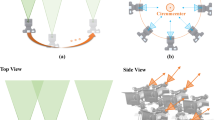Abstract
This paper addresses the light field saliency detection problem via a multiple cue integration framework. By reinterpreting the usage of dark channels in estimating the amount of defocus, a novel region-based depth feature descriptor (RDFD) defined over the focal stack is proposed. Compared to the methods which utilize the depth map as another image channel, the RDFD can produce more informative saliency cues and make less restrictive assumptions on accurate depth map or focused clear images containing dark pixels. The proposed RDFD facilitates saliency detection in the following two respects: (1) the region-based depth contrast map can be computed by measuring a pair-wise distance between super-pixels with the proposed RDFD, (2) a spatial distribution prior in the 3D space (3D-SDP) can be obtained from such depth measurements to provide high-level semantic guidances, including the gradient-like distribution in depth and the object-biased prior in image plane. Both of them contribute to generating a contrast-based depth saliency map and refining a background-based color saliency map. Finally, these saliency maps are merged into a single map using a multi-layer cellular antomata (MCA) optimizer. Experimental results demonstrate that our method outperforms state-of-the-art techniques on the challenging light field saliency detection benchmark LFSD.








Similar content being viewed by others
References
Achanta R, Estrada F, Wils P, Süsstrunk S (2008) Salient region detection and segmentation. In: ICVS. Springer, pp 66–75
Achanta R, Hemami S, Estrada F, Susstrunk S (2009) Frequency-tuned salient region detection. In: CVPR, pp 1597–1604
Achanta R, Shaji A, Smith K, Lucchi A, Fua P, Süsstrunk S (2012) Slic superpixels compared to state-of-the-art superpixel methods. TPAMI 34 (11):2274–2282
Alexe B, Deselaers T, Ferrari V (2012) Measuring the objectness of image windows. TPAMI 34(11):2189–2202
Borji A, Cheng MM, Jiang H, Li J (2015) Salient object detection: a benchmark. TIP 24(12):5706–5722
Bruce N, Tsotsos J (2006) Saliency based on information maximization. In: NIPS, pp 155–162
Cheng MM, Mitra NJ, Huang X, Torr PH, Hu SM (2015) Global contrast based salient region detection. TPAMI 37(3):569–582
Ciptadi A, Hermans T, Rehg JM (2013) An in depth view of saliency. In: BMVC, pp 112.1–112.11
Ding Y, Xiao J, Yu J (2011) Importance filtering for image retargeting. In: CVPR, pp 89–96
Donoser M, Urschler M, Hirzer M, Bischof H (2009) Saliency driven total variation segmentation. In: ICCV, pp 817–824
Duan L, Wu C, Miao J, Qing L, Fu Y (2011) Visual saliency detection by spatially weighted dissimilarity. In: CVPR, pp 473–480
He K, Sun J, Tang X (2011) Single image haze removal using dark channel prior. TPAMI 33(12):2341–2353
Itti L (2004) Automatic foveation for video compression using a neurobiological model of visual attention. TIP 13(10):1304–1318
Itti L, Koch C, Niebur E (1998) A model of saliency-based visual attention for rapid scene analysis. TPAMI 20(11):1254–1259
Jiang B, Zhang L, Lu H, Yang C, Yang MH (2013) Saliency detection via absorbing markov chain. In: ICCV, pp 1665–1672
Jiang H, Wang J, Yuan Z, Liu T, Zheng N, Li S (2011) Automatic salient object segmentation based on context and shape prior. In: BMVC, pp 110.1–110.12
Jiang P, Ling H, Yu J, Peng J (2013) Salient region detection by ufo: Uniqueness, focusness and objectness. In: ICCV, pp 1976–1983
Lang C, Nguyen TV, Katti H, Yadati K, Kankanhalli M, Yan S (2012) Depth matters: influence of depth cues on visual saliency. In: ECCV, pp 101–115
Li N, Sun B, Yu J (2015) A weighted sparse coding framework for saliency detection. In: CVPR, pp 5216–5223
Li N, Ye J, Ji Y, Ling H, Yu J (2014) Saliency detection on light field. In: CVPR, pp 2806–2813
Li X, Lu H, Zhang L, Ruan X, Yang MH (2013) Saliency detection via dense and sparse reconstruction. In: ICCV, pp 2976–2983
Liu A, Nie W, Gao Y, Su Y (2016) Multi-modal clique-graph matching for view-based 3d model retrieval. TIP 25(5):2103–2116
Liu A, Nie W, Gao Y, Su Y (2018) View-based 3d model retrieval: a benchmark. IEEE Trans Cybern 48(3):916–928
Liu T, Yuan Z, Sun J, Wang J, Zheng N, Tang X, Shum HY (2011) Learning to detect a salient object. TPAMI 33(2):353–367
Mai L, Niu Y, Liu F (2013) Saliency aggregation: a data-driven approach. In: CVPR, pp 1131–1138
Okutomi M, Kanade T (1993) A multiple-baseline stereo. IEEE Trans Pattern Anal Mach Intell 15(4):353–363
Pan J, Sun D, Pfister H, Yang MH (2016) Blind image deblurring using dark channel prior. In: CVPR, pp 1628–1636
Peng H, Li B, Xiong W, Hu W, Ji R (2014) Rgbd salient object detection: a benchmark and algorithms. In: ECCV, pp 92–109
Pentland AP (1987) A new sense for depth of fiel. TPAMI (4), 523–531
Qin Y, Lu H, Xu Y, Wang H (2015) Saliency detection via cellular automata. In: CVPR, pp 110–119
Ren J, Gong X, Yu L, Zhou W, Yang MY (2015) Exploiting global priors for rgb-d saliency detection. In: CVPR Workshops, pp 25–32
Rutishauser U, Walther D, Koch C, Perona P (2004) Is bottom-up attention useful for object recognition?. In: CVPR, vol 2, pp II–II
Shen X, Wu Y (2012) A unified approach to salient object detection via low rank matrix recovery. In: CVPR, pp 853–860
Sheng H, Feng W, Zhang S (2016) Cellular automata based on occlusion relationship for saliency detection. In: KSEM, pp 28–39
Sheng H, Zhang S, Liu X, Xiong Z (2016) Relative location for light field saliency detection. In: ICASSP, pp 1631–1635
Wang W, Wang Y, Huang Q, Gao W (2010) Measuring visual saliency by site entropy rate. In: CVPR, pp 2368–2375
Xue T, Owens A, Scharstein D, Goesele M, Szeliski R (2019) Multi-frame stereo matching with edges, planes and superpixels. Image Vis Comput 103771:91
Yan Q, Xu L, Shi J (2013) Hierarchical saliency detection. In: CVPR, pp 1155–1162
Yang C, Zhang L, Lu H, Ruan X, Yang MH (2013) Saliency detection via graph-based manifold ranking. In: CVPR, pp 3166–3173
Yang X, Qian X, Xue Y (2015) Scalable mobile image retrieval by exploring contextual saliency. TIP 24(6):1709–1721
Zhang J, Wang M, Gao J, Wang Y, Zhang X, Wu X (2015) Saliency detection with a deeper investigation of light field. In: IJCAI, pp 2212–2218
Zhang J, Wang M, Lin L, Yang X, Gao J, Rui Y (2017) Saliency detection on light field: a multi-cue approach. TOMM 13(3):32:1–32:22
Zhu W, Liang S, Wei Y, Sun J (2014) Saliency optimization from robust background detection. In: CVPR, pp 2814–2821
Zitnick C, Kang S, Uyttendaele M, Winder S, Szeliski R (2004) High-quality video view interpolation using a layered representation. In: SIGGRAPH, pp 600–608
Funding
This work is supported by NSFC under Grant 61801396 and 61531014, and by the Fundamental Research Funds for the Central Universities under Grant 3102018zy030.
Author information
Authors and Affiliations
Corresponding author
Additional information
Publisher’s note
Springer Nature remains neutral with regard to jurisdictional claims in published maps and institutional affiliations.
Rights and permissions
About this article
Cite this article
Wang, X., Dong, Y., Zhang, Q. et al. Region-based depth feature descriptor for saliency detection on light field. Multimed Tools Appl 80, 16329–16346 (2021). https://doi.org/10.1007/s11042-020-08890-x
Received:
Revised:
Accepted:
Published:
Issue Date:
DOI: https://doi.org/10.1007/s11042-020-08890-x




